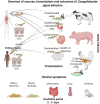Revisiting Campylobacter jejuni Virulence and Fitness Factors: Role in Sensing, Adapting, and Competing
- PMID: 33614526
- PMCID: PMC7887314
- DOI: 10.3389/fcimb.2020.607704
Revisiting Campylobacter jejuni Virulence and Fitness Factors: Role in Sensing, Adapting, and Competing
Abstract
Campylobacter jejuni is the leading cause of bacterial foodborne gastroenteritis world wide and represents a major public health concern. Over the past two decades, significant progress in functional genomics, proteomics, enzymatic-based virulence profiling (EBVP), and the cellular biology of C. jejuni have improved our basic understanding of this important pathogen. We review key advances in our understanding of the multitude of emerging virulence factors that influence the outcome of C. jejuni-mediated infections. We highlight, the spatial and temporal dynamics of factors that promote C. jejuni to sense, adapt and survive in multiple hosts. Finally, we propose cohesive research directions to obtain a comprehensive understanding of C. jejuni virulence mechanisms.
Keywords: Campylobacter jejuni; adaptation; host-pathogen; sensing; stress and survival; virulence.
Copyright © 2021 Elmi, Nasher, Dorrell, Wren and Gundogdu.
Conflict of interest statement
The authors declare that the research was conducted in the absence of any commercial or financial relationships that could be construed as a potential conflict of interest.
Figures

Similar articles
-
Pathogenicity and virulence of Campylobacter jejuni: What do we really know?Virulence. 2024 Dec;15(1):2436060. doi: 10.1080/21505594.2024.2436060. Epub 2024 Dec 8. Virulence. 2024. PMID: 39648291 Free PMC article. Review.
-
CapC, a Novel Autotransporter and Virulence Factor of Campylobacter jejuni.Appl Environ Microbiol. 2018 Aug 1;84(16):e01032-18. doi: 10.1128/AEM.01032-18. Print 2018 Aug 15. Appl Environ Microbiol. 2018. PMID: 29915112 Free PMC article.
-
The Involvement of the Cas9 Gene in Virulence of Campylobacter jejuni.Front Cell Infect Microbiol. 2018 Aug 20;8:285. doi: 10.3389/fcimb.2018.00285. eCollection 2018. Front Cell Infect Microbiol. 2018. PMID: 30177957 Free PMC article.
-
Polyphosphate and associated enzymes as global regulators of stress response and virulence in Campylobacter jejuni.World J Gastroenterol. 2016 Sep 7;22(33):7402-14. doi: 10.3748/wjg.v22.i33.7402. World J Gastroenterol. 2016. PMID: 27672264 Free PMC article. Review.
-
Pathogenic potential and genotypic diversity of Campylobacter jejuni: a neglected food-borne pathogen in Brazil.J Med Microbiol. 2017 Mar;66(3):350-359. doi: 10.1099/jmm.0.000424. Epub 2017 Mar 20. J Med Microbiol. 2017. PMID: 28317494
Cited by
-
Pinosylvin: A Multifunctional Stilbenoid with Antimicrobial, Antioxidant, and Anti-Inflammatory Potential.Curr Issues Mol Biol. 2025 Mar 18;47(3):204. doi: 10.3390/cimb47030204. Curr Issues Mol Biol. 2025. PMID: 40136458 Free PMC article. Review.
-
Comparative Genomic Analysis of Livestock-Derived Campylobacter jejuni: Antimicrobial Resistance, Virulence, Mobile Genetic Elements, and Genetic Relatedness.J Microbiol Biotechnol. 2025 Feb 14;35:e2411044. doi: 10.4014/jmb.2411.11044. J Microbiol Biotechnol. 2025. PMID: 39947677 Free PMC article.
-
Whole-genome sequencing reveals changes in genomic diversity and distinctive repertoires of T3SS and T6SS effector candidates in Chilean clinical Campylobacter strains.Front Cell Infect Microbiol. 2023 Jul 13;13:1208825. doi: 10.3389/fcimb.2023.1208825. eCollection 2023. Front Cell Infect Microbiol. 2023. PMID: 37520433 Free PMC article.
-
Survival of Campylobacter jejuni 11168H in Acanthamoebae castellanii Provides Mechanistic Insight into Host Pathogen Interactions.Microorganisms. 2022 Sep 23;10(10):1894. doi: 10.3390/microorganisms10101894. Microorganisms. 2022. PMID: 36296171 Free PMC article.
-
In Vitro Models for Investigating Intestinal Host-Pathogen Interactions.Adv Sci (Weinh). 2024 Feb;11(8):e2306727. doi: 10.1002/advs.202306727. Epub 2023 Dec 28. Adv Sci (Weinh). 2024. PMID: 38155358 Free PMC article. Review.
References
Publication types
MeSH terms
Substances
Grants and funding
LinkOut - more resources
Full Text Sources
Other Literature Sources
Medical
Molecular Biology Databases
Miscellaneous

